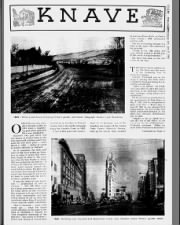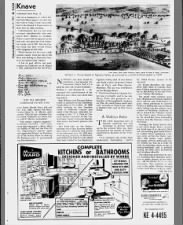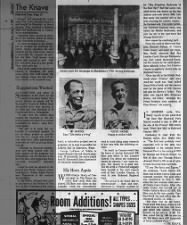 Sherwood D. Burgess
Elk Horn
Knave
Part 1
TO BLOG Sun, Jan 31, 1965 – 121 · Oakland Tribune (Oakland, California) · Newspapers.com
Sherwood D. Burgess
Elk Horn
Knave
Part 1
TO BLOG Sun, Jan 31, 1965 – 121 · Oakland Tribune (Oakland, California) · Newspapers.com |
| 1869 – White picket fence of George Potter's garden dominates Telegraph Avenue and Broadway |
In the meantime the little post office of Elk Horn folded up. Somehow or other it seems that everybody forgot all about it. Ten years ago when the late Walter N. Frickstad was preparing his book on "A Century of California Post Offices" there wasn't anyone around who could tell him where Elk Horn had once stood. Even though Frickstad's search was thorough he had to put his book to press with Elk Horn's location a question mark.
It was the belief of most historians - professional as well as amateur - that Elk Horn must have stood somewhere on the Contra Costa shores of San Francisco Bay, inasmuch as it was only natural that early communities and post offices should be set up along the waterfront where lines of communication could be readily established.
Thus it remained - until a few weeks ago - when The Knave called attention on this page to the work of Sherwood D. Burgess on "The Forgotten Redwoods of the East Bay." The names of William C. Prince and Thomas B. Prince were introduced as founders of Prince's lumber mill in the middle redwoods along San Leandro Creek in 1852.
It was at that point that Louis L. Stein Jr. of Berkeley, one of the founders and leaders of the Contra Costa County Historical Society, took up the search. Stein recalled he had seen Prince & Co. on Contra Costa County's 1853 assessment and tax rolls.
This bit of checking brought Elk Horn to life again. The assessment list recorded:
"Prince & Co., Elk Horn, 320 acres of land valued at $5,000 plus $2,000 worth of improvements.”
Elk Horn had been in the redwoods all the time.
 |
| 1965 - Buildings soar skyward and department stores now blossom where Potter's garden stood |
THE SOLE clue to rediscovering Elk Horn was the name
of the lumbering firm of Prince & Company.
Actually, Frickstad was on the verge of placing Elk Horn where it rightfully belonged during his research a decade ago.
"There is no record,” he wrote, "of a post office to serve the camps and mills in the Redwood Canyon area, although voting places were established."
Elk Horn had been established by the appointment of John Mayo on May 7, 1852, and his compensation dates from Nov. 1. From then to June 30, 1853, he was allowed $1.64 compensation, the net to the Post Office Department being $1.75. The office was officially discontinued Dec. 13, 1853.
"Inquiry so far has failed to locate the site of the office, or the reason for its establishment," Frickstad continued. "Often the name of the Postmaster furnished a...
 Sherwood D. Burgess
Elk Horn
Knave
Part 2
TO BLOG Sun, Jan 31, 1965 – 124 · Oakland Tribune (Oakland, California) · Newspapers.com
Sherwood D. Burgess
Elk Horn
Knave
Part 2
TO BLOG Sun, Jan 31, 1965 – 124 · Oakland Tribune (Oakland, California) · Newspapers.com...clue on a taxpayers or voters list, but John Mayo appears on only one, the Contra Costa County tax certified to the Board of Supervisors at their July 12, 1852, meeting.
Unfortunately, the tax rolls were arranged alphabetically with nothing to show district or location. Mayo's name did not appear on the next roll, nor upon the first Alameda County roll of 1853. But the Contra Costa list does reveal Prince and Company at Elk Horn.
Which leaves historians with another puzzle. Does the site of Elk Horn now belong in Alameda County or in Contra Costa County?
A list of post offices and postmasters in California as of August 1, 1853, published by the San Francisco Daily Herald June 3-20 and Oct. 4-15, 1854, reports Elk Horn, Contra Costa Co., A. Marier, postmaster. This list also includes Contra Costa (Oakland) in Contra Costa, with A. Marier, postmaster.
“This rather vaguely suggests," Frickstad concluded, "that something had happened to Mayo about the middle of 1852 and the Post Office Department's special agent had appointed Marier as Postmaster of the nearby office to clean up the business prior to recommending discontinuance ..."
Which leaves historians with another puzzle. Does the site of Elk Horn now belong in Alameda County or in Contra Costa County?
 |
| 1853 TAX RECORDS Underscored line tells a tale |
A list of post offices and postmasters in California as of August 1, 1853, published by the San Francisco Daily Herald June 3-20 and Oct. 4-15, 1854, reports Elk Horn, Contra Costa Co., A. Marier, postmaster. This list also includes Contra Costa (Oakland) in Contra Costa, with A. Marier, postmaster.
“This rather vaguely suggests," Frickstad concluded, "that something had happened to Mayo about the middle of 1852 and the Post Office Department's special agent had appointed Marier as Postmaster of the nearby office to clean up the business prior to recommending discontinuance ..."
 |
| From Contra Costa County Historical Society reprint of Smith & Elliott "illustrations" William C. Prince Ranch in Ygnacio Valley as pictured by a Smith & Elliott sketch in 1879 |
NOTHING has been found to contribute a background for Postmaster Mayo, but it's a good bet that the Prince brothers - William C. and Thomas B. - encouraged the establishment of the Elk Horn post office once their mill was active.
Both William and Thomas Prince voted for adoption of the California Constitution in November of 1849 while residing on San Leandro Creek in Redwood Canyon just south of the Moraga redwoods, according to Mrs. V. A. Fink of Concord, another member of the Contra Costa County Historical Society who enjoys backward glances into history.
Mrs. Fink tells us the Prince brothers were Ohio farmers before they came to California and settled in the redwoods here. By 1852 they were buying property in Martinez, and at that time held five lots which they later traded to Asa Bowen for Ygnacio Valley land. It was Bowen who built a hotel on former Prince lots at Ferry and Main Streets, Martinez. The inn was well known as the Morgan House.
The Prince Ranch in Ygnacio Valley was eventually sold to the late Percy Treat who prospered as a breeder of thoroughbred racehorses. The old ranch home stood until very recently on Treat Lane, about a quarter-mile east of Oak Grove Road.
THE LAST important relic of Spanish California that had remained in private hands up to the present time has been presented to the Society of California Pioneers Museum in San Francisco.
"It is certainly one of the most historically fascinating," reports Dr. Elliot Evans, curator of the museum.
Dr. Evans describes the handsome field chest of General Mariano Vallejo presented to the society by the family of the late Francesca Vallejo McGettigan.
The small chest contains more than 100 pieces of French Sheffield silver service and Waterford cut glass, items presented to General Vallejo in 1834 by the Czar of Russia while Vallejo was the military commander of Northern California. It was a reward for Vallejo's rescue of the Czar's niece, Princess Helena. He saved her from marauding Indians near the Russian colony of Fort Ross.
Although the brass bound chest is not much larger than a present day brief case it is cleverly fitted out with nestling gold tooled Morocco leather trays containing a formal silver service for three, complete with plates, cups, goblets, saucepans, service dishes and candle holders as well as a toilet kit with six matching razors, a pair of folding bootjacks and a portable writing set with ivory accessories and cut glass inkwells.
The chest was previewed by society members last Thursday and is now on public display at the museum, 456 McAllister Street, San Francisco. The museum is open free to the public Monday through Friday from 10 a.m. to 4 p.m. daily.
-THE KNAVE
 Erasmus Brown "Brown Valley" Sun, Aug 1, 1965 – 156 · Oakland Tribune (Oakland, California) · Newspapers.com
Erasmus Brown "Brown Valley" Sun, Aug 1, 1965 – 156 · Oakland Tribune (Oakland, California) · Newspapers.comElk Horn Again
WHEN Gladys Shally of Canyon read in The Knave recently that Louis Stein had placed Elk Horn post office on San Leandro Creek she immediately went to work doing some research of her own with the following results:
"As much as Canyon would like the honor of having historical Elk Horn post office in San Leandro Canyon I'm afraid the distinction cannot be claimed," her report begins. The reason is a good one. The 320 acres of Prince & Company were located in the next canyon west of San Leandro Canyon, in what is now Redwood Regional Park.
"The mixup is no doubt due to nomenclature - then and now. Sherwood D. Burgess explains in his "The Forgotten Redwoods of the East Bay" that the entire redwood forest was known as the San Antonio redwoods before 1849. Late that name was applied only to the area covering the western slopes - the Oakland side. The center forest, now Redwood Regional Park, was called the Middle Redwoods, and over the hill to the east were the Moraga Redwoods."
Now comes the confusing part.
From the work of Sherwood Burgess, Slocum's history of Contra Costa County, and some old maps, Mrs. Shally observes that San Leandro Creek (Moraga Redwoods) was first called Redwood Creek, and the canyon by the same name. Even officially today, San Leandro Canyon is popularly known only as Redwood Canyon,
"Over the hill in the Middle Redwoods where Princes' mill once stood the creek was then called Grass Policy Creek, and the canyon went by the name of Mill Canyon and also by Brown's Valley. This latter was named after Erasmus Brown, not Elam; although the Prince brothers were nephews of Elam Brown," she reports.
[This was confusing to me, too. Old articles refer to both drainages as "Redwood Canyon." I'd separately puzzled this out in two other posts, Then and now in "Redwood Canyon" and OVER THE HILLS - 'Cyclers Take Trip to Walnut Creek - Oakland Tribune, 08 May 1889, Wed, Page 3 using different source materials. - MF]
[This was confusing to me, too. Old articles refer to both drainages as "Redwood Canyon." I'd separately puzzled this out in two other posts, Then and now in "Redwood Canyon" and OVER THE HILLS - 'Cyclers Take Trip to Walnut Creek - Oakland Tribune, 08 May 1889, Wed, Page 3 using different source materials. - MF]
IN ANOTHER aside, Mrs. Shally reports at this point that the East Bay Regional Park District erected a sign in 1953 at the site of the Princes' Mill which read, "First Saw Mill in Redwood Canyon—1852."
Continuing to read from the Burgess report, Mrs. Shally tells us, “The first and probably most important mill in this area was established in the canyon below Redwood Peak in the spring of 1852 by Thomas and William Prince. In July of that year Thomas Prince obtained titled to 320 acres of public land on school land warrants.
"If you like facts and figures," she continues, "Louis Stein's Elk Horn was in both Contra Costa and Alameda counties. The post office was established on May 7, 1852, when the two counties were one - all Contra Costa County. After Alameda County was formed out of Contra Costa in March of 1853, Elk Horn was in the new county. Very short-lived, the post office was discontinued on Dec. 17, 1853.
"Elk Horn was an apt name. There must have been plenty of elk in that area at the time Elk Horn post office was named. William Brewer, in his survey of Mt. Diablo, noted that by 1860 he saw no elk, but there were still thousands of horns scattered about.”
-THE KNAVE
Game was once very abundant—bear in the hills, and deer, antelope, and elk like cattle, in herds. Russell said he had known a party of thirty or forty to lasso twenty-eight elk on one Sunday. All are now exterminated, but we find their horns by the hundreds. - Up and down California in 1860-1864; the journal of William H. Brewer
Comments
Post a Comment